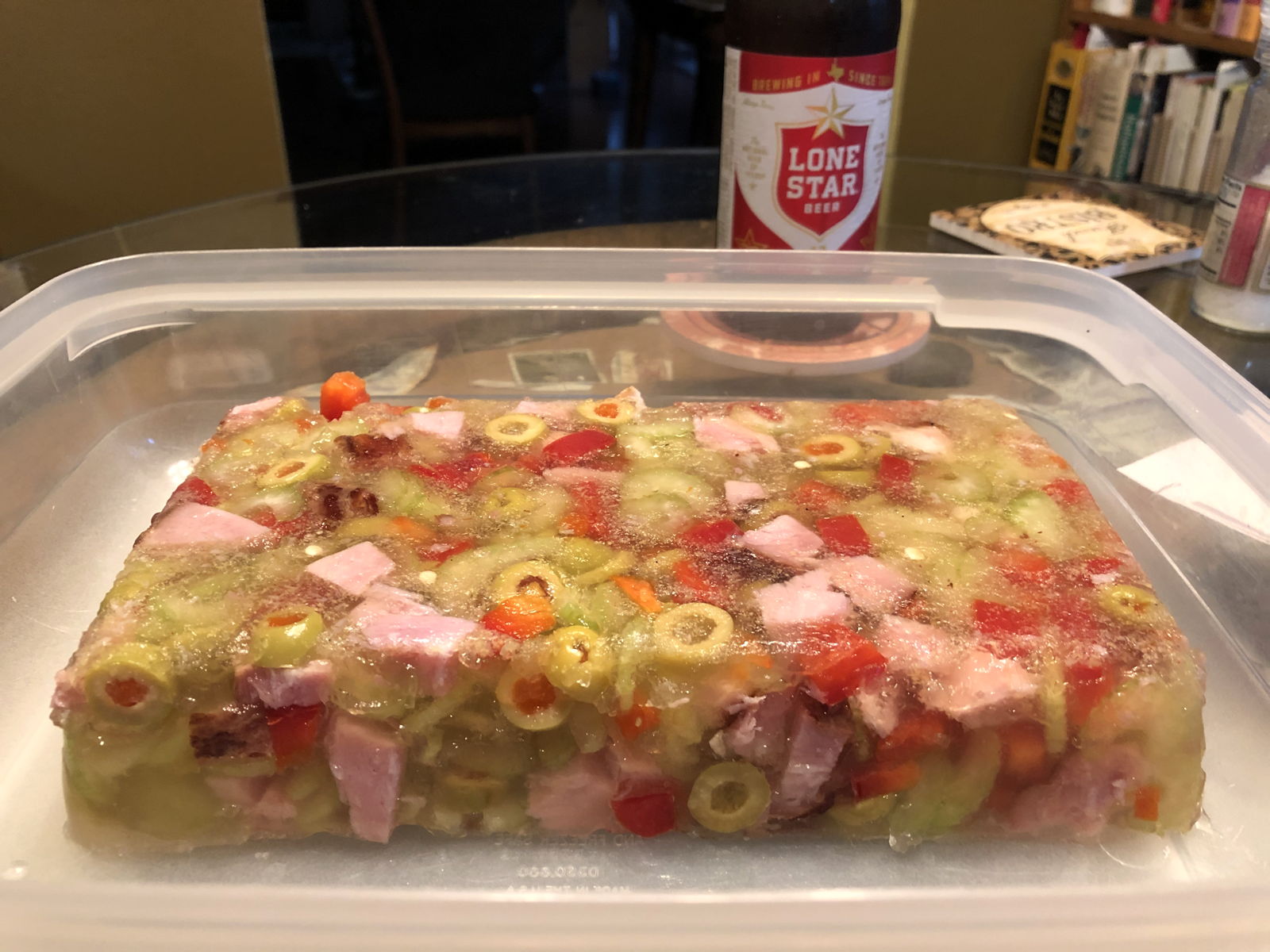Refrigerator Revolution Revisited: 1942 Cold Cooking
For all its reliance on gelatin, Cold Cooking (PDF File, 9.9 MB) has some wonderful recipes.
In the 1931-1946 editions of The Joy of Cooking, Irma Rombauer wrote at the start of her section on Bombes and Mousses:
Today similar recipes are to be found in any book on Iceless Refrigeration. Modern equipment has made these dishes commonplace, but for me they retain a certain glamour associated with distinguished company, conviviality and the easy flow of intellectual conversation.—Irma S. Rombauer, The Joy of Cooking, p. 689
By “iceless refrigeration” she meant electric refrigerator/freezers. It’s fascinating that she chose to capitalize the phrase, much like Frigidaire eschewed articles when referring to their refrigerator in Frigidaire Recipes in 1928. By 1942 (and then 1947 for my upcoming third installment) Montgomery Ward didn’t title their manual as if choosing their brand was a lifestyle choice, as Frigidaire had. They titled it “Cold Cooking” much as Osterizer would title their blender manual decades later “Spin Cookery”. It was an Appliance That Does Things. It Cold Cooks.
Revolution: Home Refrigeration
- Frigidaire, 1928
- Cold Cooking, 1942 <-
- Cold Cookery, 1947
In 1928, when Frigidaire included Frigidaire Recipes with their new refrigerators, about 65% of dwellings in the United States had access to electric service. Only 7.3% of farms did. The cost of electricity was, on average, about seven cents per kilowatt-hour.
Fourteen years later in 1942, when Montgomery Ward published Cold Cooking (PDF File, 9.9 MB), 81% of dwellings and 38% of farms had electricity. The cost of electricity had dropped 25%, to around five cents, depending on how much you used.
This meant that, unlike Frigidaire in 1928, Montgomery Ward’s market included rural consumers. One of the things that rural homeowners have access to that urban homeowners do not is outdoor space to store food. In the winter, when it gets cold, food was traditionally stored underground (for a moderate, steady temperature) or in the ice and snow (for a freezing temperature).
If Cold Cooking is to be believed, some rural refrigerator owners turned their refrigerators off in the winter.
…you will not be economizing by shutting it off in the winter… If you put perishable foodstuffs on the back porch or in the cellar they may freeze which will destroy flavor and then, too, you quite naturally wish to “save steps,” so the food will remain in the warm kitchen for long periods at a time… Remember the cost of one spoiled roast will probably pay for a month of running costs… So, place your refrigerator where it is easily accessible and use it constantly.
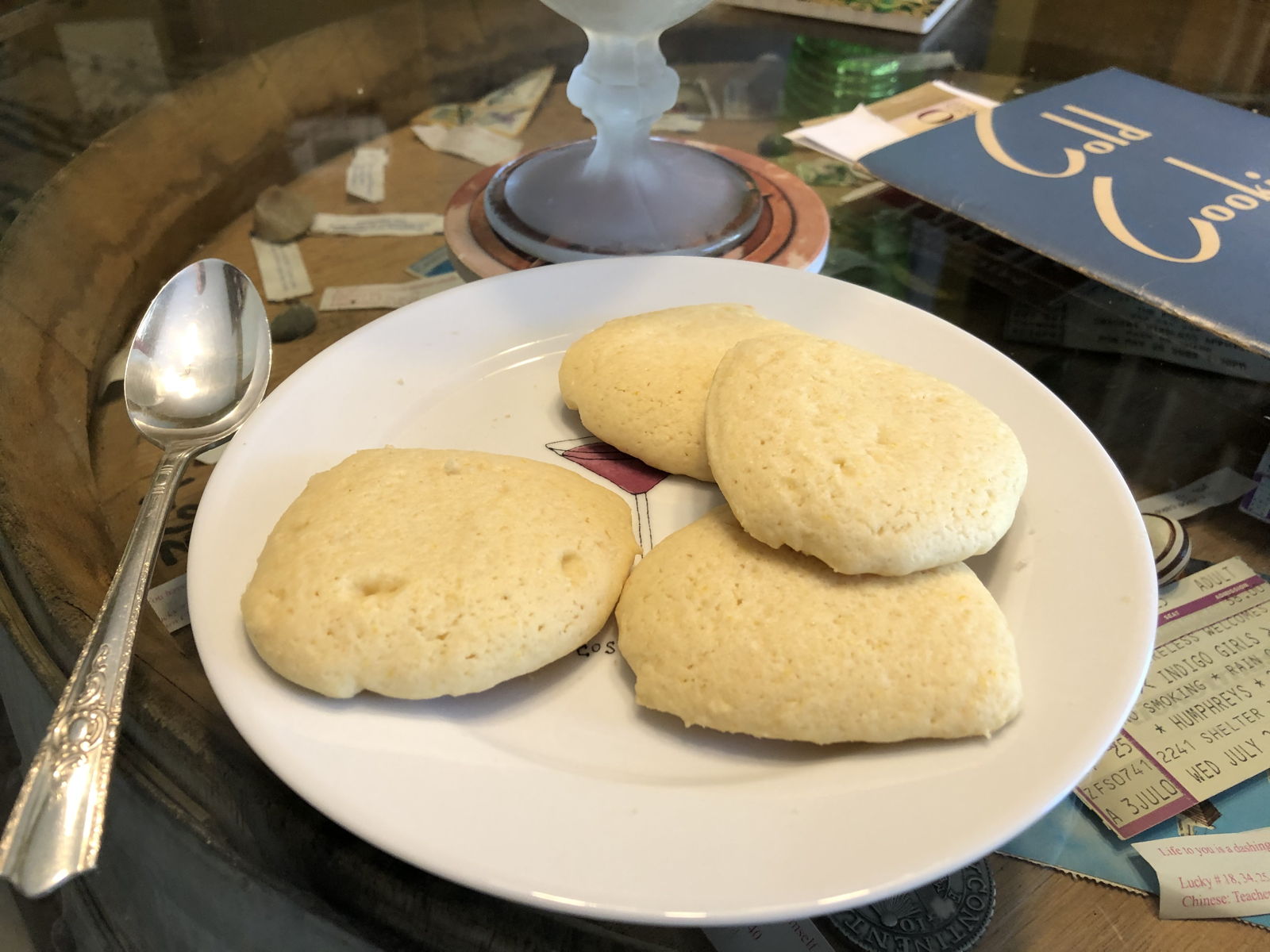
Sunshine cookies. Refrigerators make a new kind of light cookie dough possible.
In other words, don’t give in to temptations to turn your refrigerator off when it gets cold outside, and don’t put your refrigerator outside to begin with. The savings aren’t as much as you might think.
It’s entirely possible, of course, that it wasn’t just a matter of saving money that tempted rural homeowners to keep their refrigerators in the cold. If their early access to electricity was sporadic, as one might expect when power lines iced over and wind turned to gale, they may have trusted mother nature more than they trusted the grid.
You still see this today outside of the United States: even people on the grid, if they can afford it, will have a generator to take up the slack when the power inevitably and regularly goes out. Increasingly, even Americans are installing power generators to offset unreliable energy as we move more and more to intermittent sources.
Cold Cooking differs from, at the same time it is similar to, Frigidaire Recipes in another way. Montgomery Ward, like Frigidaire, published this to help sell refrigerators. Like Frigidaire Recipes, Montgomery Ward’s Cold Cooking also treats their refrigerator as a marvelous means of making food, not just for storage. It’s in the title of the manual: the refrigerator actively helps in cooking food. But Montgomery Ward’s refrigerator, rather than a capitalized new lifestyle sans articles, is a modern appliance, no different than any other kitchen appliance.
You will marvel at the small amount of time you must spend in taking care of your refrigerator. Keep it clean as you would any appliance used in preparing food, defrost it once each week.
It is always ready to jell soups, salads, desserts—to chill fruit or vegetable juices—to crisp salad greens—to make ice creams, mousses, etc.—to freeze ice cubes. Use it. If this is your first electric refrigerator, don’t think of it as just a place to store foods—make it work for you and save for you.
Judging from other vintage cookbooks of the era and well afterward, jelled foods used to be popular and common. Gelatin meals certainly appear to be a major reason for buying a refrigerator in 1942. In Frigidaire Recipes there are only three gelatin recipes: Tomato Jelly Salad (44); Fruit and Vegetable Salad (45); and Jellied Soup (60). There are short references to it on two other pages.
Jellied bouillon may be ready for next day’s dinner, in service cups or chilled in bowl or pan, to be chopped or cubed for a choice platter of cold meats. (p. 70)
Gelatine desserts are quickly completed if the gelatine mixture is placed in the chilling unit to congeal; be careful not to let it freeze, however. Both salads and desserts with a gelatine foundation are safely made for two days’ service with the low temperature of Frigidaire. (p. 73)
“Gelatine” was an ingredient of the relatively well-to-do in 1928. Those who needed a “choice platter of meats” or dainties served in “service cups”. In Cold Cooking, however, there are gelatin recipes running through every section, and it’s not about a choice platter for the sideboard! From whipped evaporated milk (9) through various jellied soups (14-15), savory molded jellies (18-22), sweet and savory molded salads (24-28), ice creams and mouses (34-42), and pies and soufflés (46-49)1 gelatin has, by 1942, become much more than an upscale dish.
Gelatin had been pioneered as a mass market item at the turn of the century. What happened between 1928 and 1942 to turn it into such a selling point for refrigerators that it practically takes over the book? My guess is the Great Depression. Cold Cooking’s “Jellied Supper Ring” (pictured here as a loaf) is a cup of chopped ham and about a cup and a half or two cups of chopped vegetables: celery, bell pepper, and stuffed olives, suspended in one package of lemon gelatin.2
The dish was fine. In fact, it was quite good. But it would have been better if I’d just taken the same ingredients and used a dressing of lemon juice and olive oil instead of going to the trouble to set it in lemon gelatin. If I’d done that, however, I would have had maybe two servings. Adding gelatin made it into six servings, easy, and not just because gelatin makes for larger portion sizes. Gelatin is and was an inexpensive source of protein. While gelatin appears to have been advertised as an elegant, democratized food once the sole province of the wealthy, I suspect that after a decade of depression it also was a means of stretching food budgets.
Something I didn’t catch immediately is that the Jellied Supper Ring is a supper, that is, a meal after dinner. Both of the gelatin recipes on this page have “supper” in the title. In my defense, in my family, “supper” means the evening meal—what most people call dinner. But if “supper” is used with the more common meaning of a late night light meal or snack, setting it in gelatin in the refrigerator would keep it fresh-tasting even when made much earlier. This hearkens back to Irma Rombauer’s “certain glamour” that refrigerators offer to the average consumer. You could go out to a movie or a play, and come back to a post-entertainment supper already prepared.
Even more glamorous would be the ice creams. The Maple Ice Cream in Cold Cooking would have been a perfect addition to a traditional supper. And it could only be made in a refrigerator/freezer. It’s a very simple ice cream: beat cream, maple syrup, and eggs, with vanilla and a touch of salt, freeze slightly, beat again, and then freeze hard. It takes time to make: the first freeze took about three hours; the second freeze took overnight—and perhaps longer. I made it on Saturday, I had a bowl on Sunday, and then I had a bowl again this morning. I’m pretty sure it was even better this morning than yesterday morning.
But while it takes a lot more time to make ice cream in the refrigerator, it takes a lot less work. There is no cranking, no gathering ice and salt. Beat it, maybe, and maybe not. Put it in the freezer. And go on with something else. The recipe for Coffee Marlow goes out of its way to tell the cook what not to do. “Do not stir.” Anyone making this would recognize that it’s basically an ice cream, so “of course” it would have to be re-stirred after a short freeze to keep it from separating. But the then-modern electric refrigerator-freezer froze things quickly enough that, combined with the use of marshmallows, that step was unnecessary.
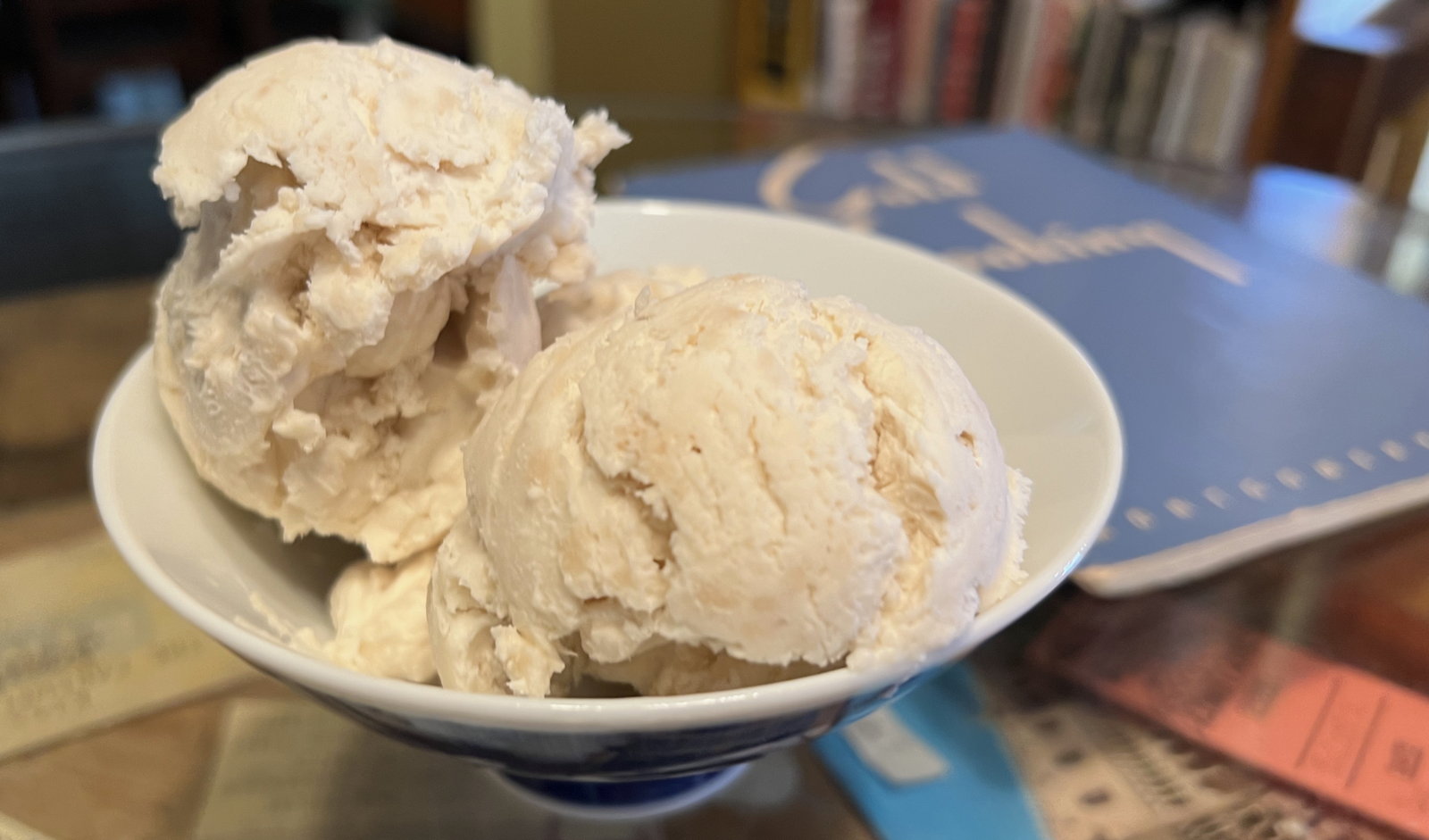
Coffee Marlow
Servings: 6
Preparation Time: 1 hour, 30 minutes
Montgomery Ward’s Cold Cooking (PDF File, 9.9 MB)
Ingredients
- ½ lb marshmallows
- ½ cup hot coffee
- 1 cup whipping cream
Steps
- Melt marshmallows over hot water.
- Add hot coffee and mix thoroughly.
- Cool to room temperature.
- Chill very slightly and beat well.
- Beat cream to a barely-whipped custard consistency.
- Fold beaten cream into marshmallows.
- Pour into a cold dish and freeze overnight.
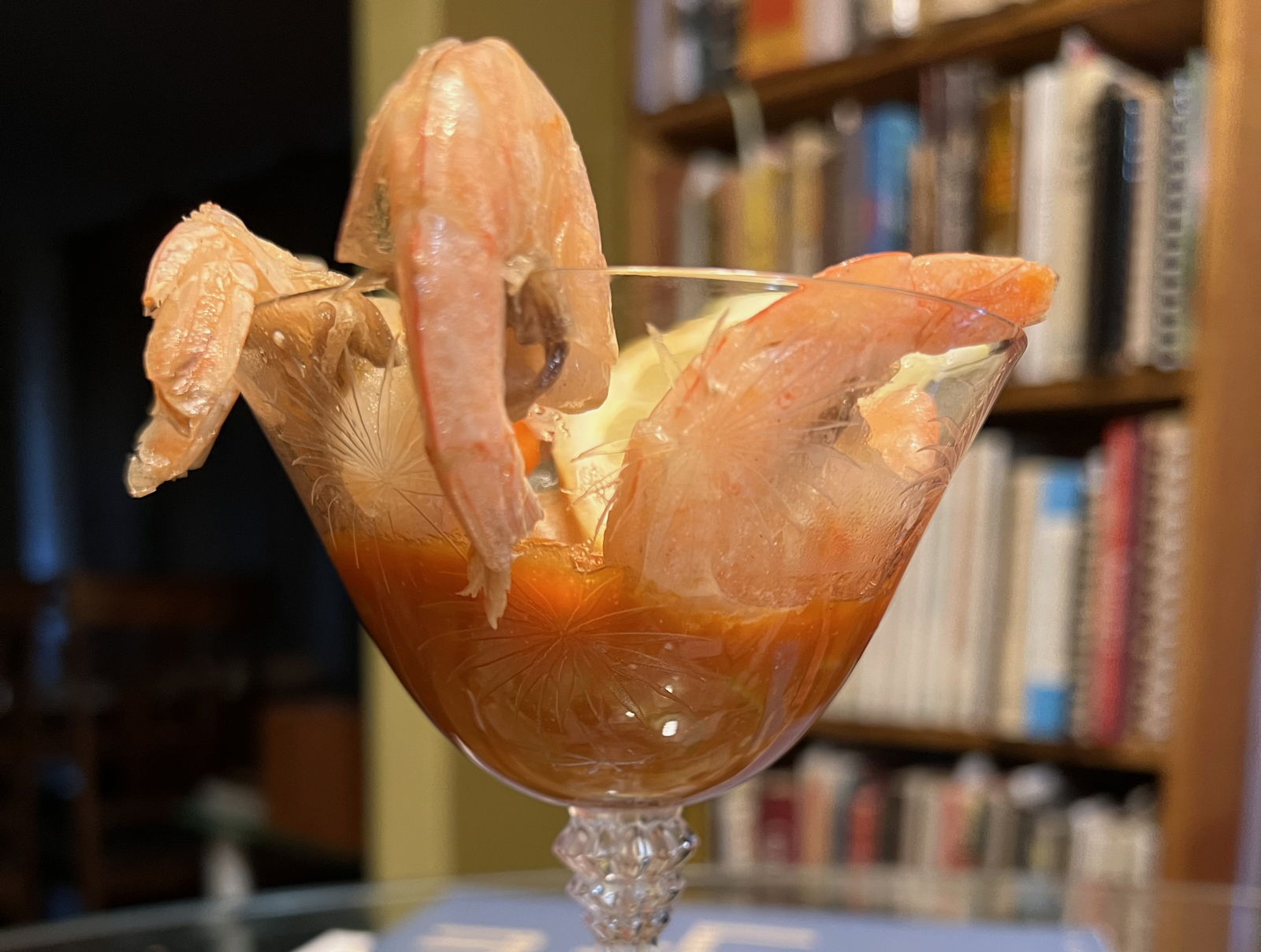
An amazing start to a meal on a hot day, using ingredients and a presentation that both rely on reliable home refrigeration.
It’s an amazing, elegant, and easy recipe. It stores well in the freezer and wouldn’t work without it.
A lot of the recipes are a bit of a stretch as far as being “refrigerator” recipes. Combine cocoa, sugar, and water into syrup, mix in some milk, and “Serve very cold”. Or mix lemon juice and orange juice “and chill. Serve with ice cubes.” Voila, refrigerated beverages! Of course, if you’d never seen a refrigerator before, it was probably a lot more impressive. You can hear exactly that in Rombauer’s association of such dishes with glamor and intellectual conversation.
With an electric refrigerator many foods may be prepared in advance and kept until you are ready to use them. The salad, dessert and rolls for a meal may be prepared the night before or in the morning for dinner that evening. You may also want to keep sandwich spreads and fillings in your refrigerator ready to serve, or perhaps some unusual cool summer drink to delight thirsty children or charm a tea guest on a warm afternoon.
A case in point is the section on “Foods that start a meal” that itself begins with three pages of elegant food cocktails. Before the personal refrigerator, these dishes would be limited to wealthy households or upscale restaurants. For the Shrimp Cocktail on page 10, the only role of the refrigerator is to “Chill all ingredients thoroughly”. But it is a critical role. Unlike the drinks served cold, these are recipes where part of the presentation is serving cold; without a refrigerator you don’t make them at home, you go out to eat them. Now, you can make them in your own refrigerator, and store them in your refrigerator until needed.
An appetizer helps just an ordinary meal become “special”… Don’t wait until you have guests! Give the family a treat by serving an appetizer tonight, even if it is only a stuffed celery stalk.
I assume from the instructions that the Shrimp Cocktail is meant to use canned shrimp—there’s nothing in it about how to cook the shrimp. I didn’t have canned shrimp on hand, but I did have raw shrimp in the freezer—bought months ago, something I literally couldn’t do if I didn’t have one of these amazing appliances!—so I cooked it up normally and chilled it. I’m not sure you can get a better combination of elegant, easy, and fast.
Like the earlier Frigidaire manual, Montgomery Ward’s Cold Cooking continues to address people who haven’t used a refrigerator before rather than people already familiar with the appliance. That’s probably one of the reasons they seem to be addressing rural homeowners with such admonitions as not to turn the refrigerator off in the winter: Montgomery Ward was a mail order outlet, delivering to consumers far from a showroom or factory, who had only recently acquired electricity.
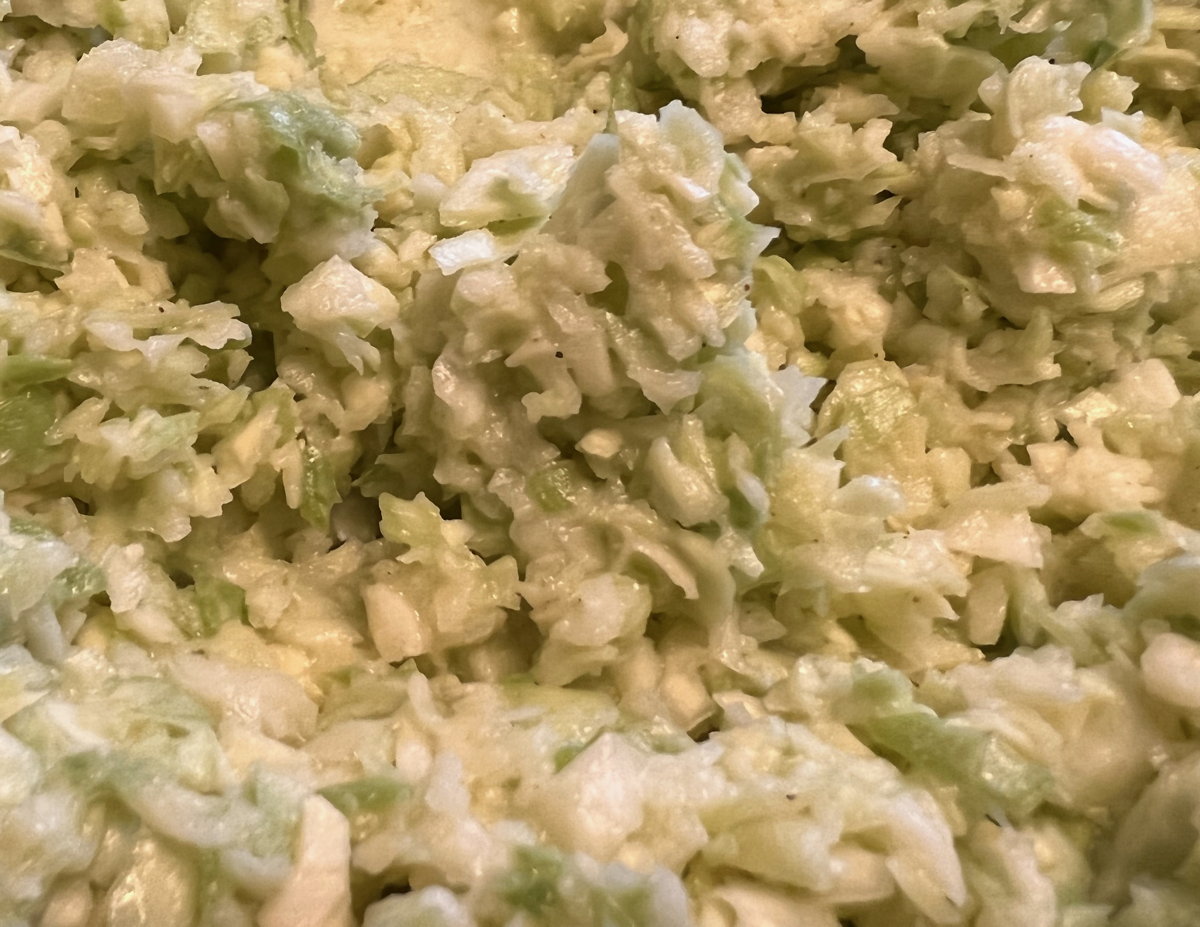
Coleslaw made with an 1897 salad dressing. That was well before reliable refrigeration.
Some of the things that a refrigerator makes possible are so common now we don’t even think about them. People used to do the shopping for the day’s food on the day it was going to be eaten. Having a refrigerator, however, meant that:
You can now do the shopping for several days at one time; the refrigerator will keep food fresh for you. Because of this, it will be easy to plan your meals in advance.
The refrigerator isn’t quite a cupboard with unlimited storage time. But it is a lot better than having to make do with only what was available at the market or out in the fields this morning.
The refrigerator also made possible sandwich spreads that lasted without canning. Cold Cooking suggests taking “a few minutes time some day and prepare a few delicious spreads. They will keep for several weeks and be ready to serve at a moment’s notice.”
These include things like peanut butter and chopped ginger, or date paste and nuts—I’ve made ground dates and nuts before, and it is a marvelous spread. There are also cheeses mixed with vegetables, butter with anchovy, and quick pickles. These almost all were once the province of a sideboard in wealthy households. Now, they’re available to anyone with a refrigerator.
Salad was another new taste for many people, because now you could make salad dressing and keep it in the refrigerator! Here’s how a boiled salad dressing looked in the 1897 Charlotte Cook Book:
Beat yolks of eight eggs, add to them a cup of sugar, one teaspoon each of salt, mustard and black pepper, and a half a cup of cream; mix thoroughly. Bring to a boil a pint and a half of vinegar, add one cup of butter, let come to a boil, pour upon the mixture, stir well and when cold put into bottles, or put in a cold place. It will keep for weeks in the hottest weather and is excellent for cabbage or lettuce.—Mrs. D. B. Ainger (The Charlotte Cook Book p. 29)
I’ve made this recipe; it’s a good one. But the predominance of vinegar to ensure that it “keep for weeks” definitely limits the kinds of salads that can be made from it. In contrast, the Boiled Dressing in Cold Cooking, with similar ingredients, uses far less vinegar and far more cream.
Even where items still required canning, the refrigerator opened up possibilities that didn’t exist before, items that could be kept refrigerated after sealing. I haven’t tried it, but there’s an interesting recipe for Chocolate Syrup on page 19 that involves boiling, sealing, and then keeping in the refrigerator until needed.
From the choice of a paperback rather than a hardcover, to the rise of gelatin as a major ingredient, to the use of photographs rather than elegant illustrations, the differences between Montgomery Ward’s 1942 cookbook and Frigidaire’s 1928 cookbook reflect changing economic circumstances, changing technology, and the spread of a more affluent lifestyle far beyond the urban elite.
Ubiquitous and reliable electricity wasn’t just democratizing the world of communications. It was democratizing the very food we ate, and providing options in a world of government-imposed scarcity—first during the Depression and then into World War II—that would have meant starvation in earlier eras.
In response to Revolution: Home Refrigeration: Nasty, brutish, and short. Unreliable power is unreliable civilization. When advocates of unreliable energy say that Americans must learn to do without, they rarely say what we’re supposed to do without.
Cold Cooking gelatins: Whipped Evaporated Milk (9); Jellied Consomme (14); Jellied Celery Bouillon (15); Jellied Tomato Bouillon (15); General Jellied Soup Recipe (15); Ham Buffet Loaf (18); Tomato Aspic (22); Lemon Aspic (22); Cheese Ring (22); Cheese and Blueberry Salad (24); Pepper Circle Salad (24); Moulded Raw Cranberry Salad (25); Perfection Salad or Jellied Cole Slaw (25); Jellied Waldorf (26); Jellied Strawberry Salad (26); Tuna Fish Salad (26); Moulded Seafood (27); Moulded Chicken Salad (27); Cauliflower, Nut and Tomato Aspic Salad (28); Vegetable Supper Ring (28); Jellied Supper Ring (28); Pineapple Mint Sherbet (34); Philadelphia Ice Cream (36); Vanilla Mousse (41); Coffee Mousse (42); Fresh Strawberry Bavarian Cream (42); Coffee Rice Bavarian Cream (42); Macaroon Bavarian Cream (42); Frozen Coffee Dessert (46); Lemon Chiffon Pie (46); Pumpkin Chiffon Pie (47); Orange Gelatine Souffle (47); Snow Pudding (48); Grapejuice Sponge (48); Refrigerator Chocolate Pie (49).
↑I didn’t have lemon gelatin on hand when I made this dish, but I did have lemons, so I used unflavored gelatin and the zest and juice of one lemon.
↑
Download
- Refrigerator Revolution Revisited: 1928 Frigidaire
- The 1928 manual and cookbook, Frigidaire Recipes, assumes a lot about then-modern society that could not have been assumed a few decades earlier.
- Refrigerator Revolution Revisited: 1947 Cold Cookery
- The 1947 Norge Cold Cookery and Recipe Digest reflects not just increased access to electricity but also the end of a second world war.
- Montgomery Ward’s Cold Cooking (PDF File, 9.9 MB)
- The 1942 Montgomery Ward & Co., Inc.’s Cold Cooking refrigerator manual and cookbook.
electrical power
- Historical Statistics (Colonial to 1957) at United States Census Bureau
- “Preparation of historical tables showing energy from various sources and total energy input on a per capita or other basis is complicated. The amounts shown will differ greatly depending on the basis and point of measurement used.”
- How the 1920s Thought Electricity Would Transform Farms Forever: Matt Novak
- “Of the roughly 6.3 million American farms in 1922, only about 3% had electricity… But in 1922… Science and Invention magazine featured their vision of the farm of tomorrow—the Electric Farm de Luxe!”
- Montgomery Ward’s First Catalog at Chicago History Museum
- “The well-known company was founded by Aaron Montgomery Ward in 1872, with a mission to make its products more available to the public, especially consumers in rural and farming communities… What made Ward’s catalog the first of its type was its accessibility. It was the first extensive mail order catalog for the masses.”
- Our Cybernetic Future 2023: Entropy in Action
- Studying the past, we can improve the future. Studying the futurists of the past, we can learn the tools to improve the future.
food history
- Ice cream from your home freezer
- You can make great ice cream with whole eggs, egg yolks, and egg whites. You can even make it without eggs at all. All you need is syrup and cream—and a refrigerator with a freezer or a standalone home freezer.
- Review: The Charlotte Cook Book: Jerry Stratton at Jerry@Goodreads
- This 1893 community cook book is a fascinating look at cooking and baking before much of the technology we now rely on, such as refrigeration.
- Review: The Joy of Cooking: Jerry Stratton at Jerry@Goodreads
- This edition of Irma Rombauer’s influential book is old enough to be at the dawn of chocolate chips.
More cookbooks
- My Year in Food: 2024
- From Italy, to San Diego, to Michigan, and many points in between; and from 1876 up to 2024 with stops in the 1920s, this has been a great food year.
- Mrs. Winslow’s Domestic Receipt Book for 1876
- If this is what people were eating in 1876, they were eating very well. From coconut pie to molasses gingerbread to tomato jam, these are great recipes—albeit requiring some serious interpretation.
- Stoy Soy Flour: Miracle Protein for World War II
- To replace protein lost by rationing, add the concentrated protein of Stoy’s soy flour to your baked goods and other dishes!
- Rumford Recipes Sliding Cookbooks
- One of the most interesting experiments in early twentieth century promotional baking pamphlets is this pair of sliding recipe cards from Rumford.
- A Traveling Man’s Cookery Book
- A Traveling Man’s Cookery Book is a collection of recipes that I enjoy making while traveling, and in other people’s kitchens.
- 68 more pages with the topic cookbooks, and other related pages
More Montgomery Ward
- Revolution: Home Refrigeration
- Nasty, brutish, and short. Unreliable power is unreliable civilization. When advocates of unreliable energy say that Americans must learn to do without, they rarely say what we’re supposed to do without.
More Refrigerator Evolution
- Refrigerator Revolution Revisited: 1928 Frigidaire
- The 1928 manual and cookbook, Frigidaire Recipes, assumes a lot about then-modern society that could not have been assumed a few decades earlier.
- Refrigerator Revolution Revisited: 1947 Cold Cookery
- The 1947 Norge Cold Cookery and Recipe Digest reflects not just increased access to electricity but also the end of a second world war.
More refrigerators
- Refrigerator Revolution Revisited: 1947 Cold Cookery
- The 1947 Norge Cold Cookery and Recipe Digest reflects not just increased access to electricity but also the end of a second world war.
- Refrigerator Revolution Revisited: 1928 Frigidaire
- The 1928 manual and cookbook, Frigidaire Recipes, assumes a lot about then-modern society that could not have been assumed a few decades earlier.
- Ice cream from your home freezer
- You can make great ice cream with whole eggs, egg yolks, and egg whites. You can even make it without eggs at all. All you need is syrup and cream—and a refrigerator with a freezer or a standalone home freezer.
- Revolution: Home Refrigeration
- Nasty, brutish, and short. Unreliable power is unreliable civilization. When advocates of unreliable energy say that Americans must learn to do without, they rarely say what we’re supposed to do without.

